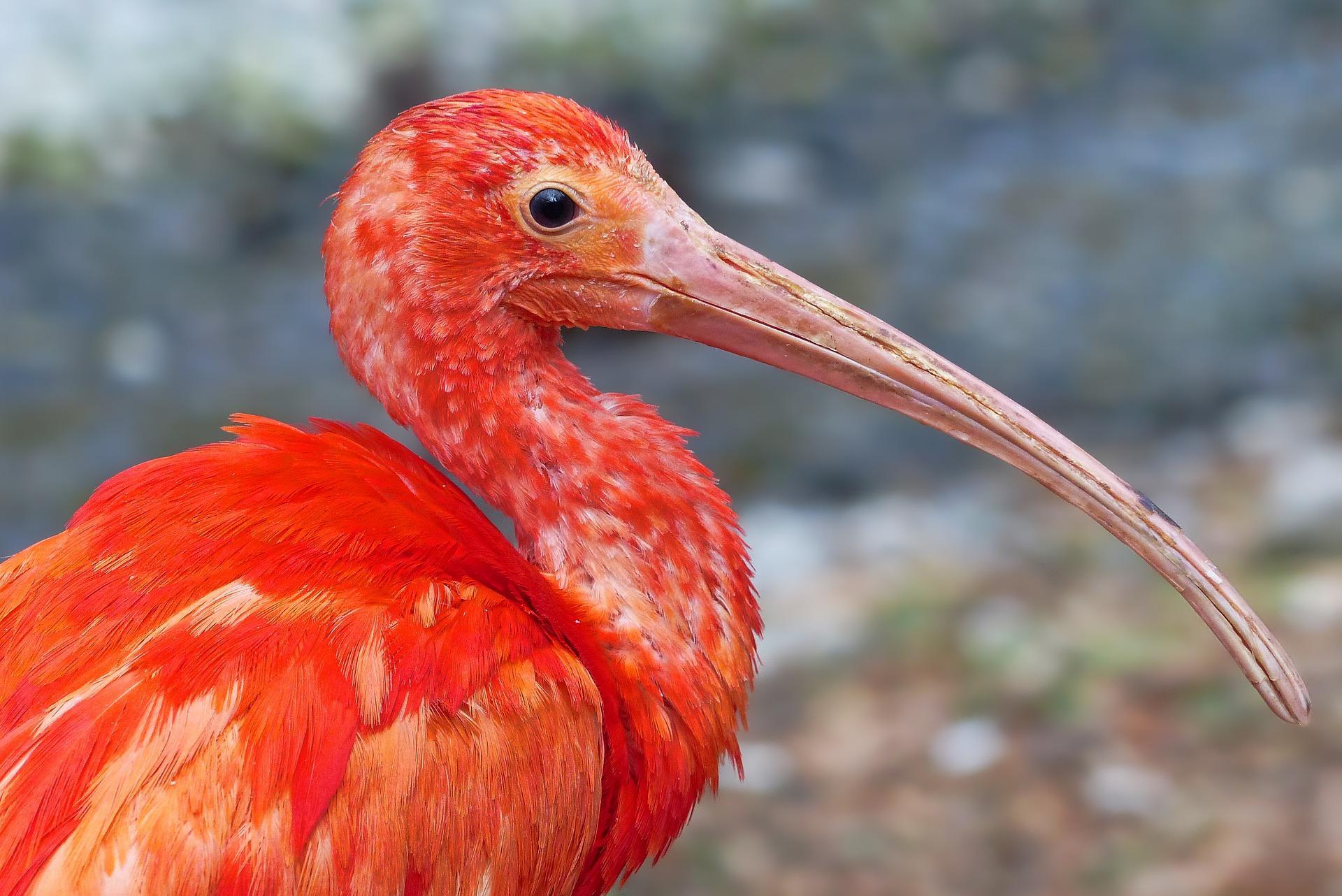Types of Birds With Long Beaks


A beak, also called bill or rostrum, is an external anatomical structure mostly found in birds. It's used for eating, preening, manipulating objects, killing prey, fighting, searching for food, courtship and feeding their young. Beaks can vary significantly in size, shape, color and texture, but are nevertheless similar in the underlying structure.
In this AnimalWised article we are going to talk about the different types of birds with long beaks. We'll go through the characteristics and then give you examples of long-beaked birds with photos.
Characteristics of bird beaks
All beaks are similar in their underlying structure. They consist of two bony projections, the upper and lower mandibles which are covered with a thin keratinized layer of epidermis known as the rhamhotheca. In most species, you will also find two holes called nares that lead to the respiratory system.
Since birds do not have teeth, they generally swallow their food whole. Their stomach is adapted to this fact and divides into a glandular and muscular stomach that allows them to digest their food properly.
As we've previously mentioned, bird beaks come in a wide variety of shapes and sizes. Some have bright colors, like Toucans. Others have bumps like the Calao birds. Pigeons have skin at the tip of their beaks, while others don't. Ducks and geese have lamellae as teeth while most birds do not.
Long bird beaks
Many species of birds have a long beak. This type of beak is especially present in birds that have more specific feeding habits. For example, birds that need to remove mud or sand, birds that live in certain flooded habitats, etc.
Having a long beak will help these birds not have to get all of their plumage wet and be able to look for food in these environments while still maintaining their field of vision on the surface. In addition, many species also have certain beak flexibility to help them bury it in the sand or mud in search of small vertebrates.
Some birds, such as storks, have long legs and a long beak that allow them to catch fish to feed on. Other birds, like hummingbirds, need their long beaks to reach the nectar of certain flowers that other birds can't reach. Other birds with arboreal habits use their long beaks to insert it into holes in tree branches or bark.
We'll see these characteristics in the examples of long-beaked birds below.
Examples of birds with long beaks
Next, we will show you some examples of birds with long beaks according to the order they belong to:
Long-billed birds of the Charadriiformes order
Among the Charadriiformes birds with the long beak, the following birds stand out:
- The common avocet (Recurvirostra avosetta): distributed throughout Asia, Africa and Europe, unmistakable for its unique long and upturned beak. It feeds on small invertebrates while it “sweeps” areas with shallow water and also filters its food from the mud.
- Long-billed seamstress (Limnodromus scolopaceus): this bird inhabits North America and Siberia, in the tundra. Its unique long beak helps it in the search for food, since these birds are waders and feed by wading in shallow waters where the beak submerges.
- American Curlew (Numenius americanus): this is another shorebird that inhabits North America and has a long curved beak with which it searches for food in the sand or mud. This species has suffered a reduction in its populations due to the loss of its habitat and is currently under the “near threatened” category.
You may also be interested in our article about the different types of bird feet.
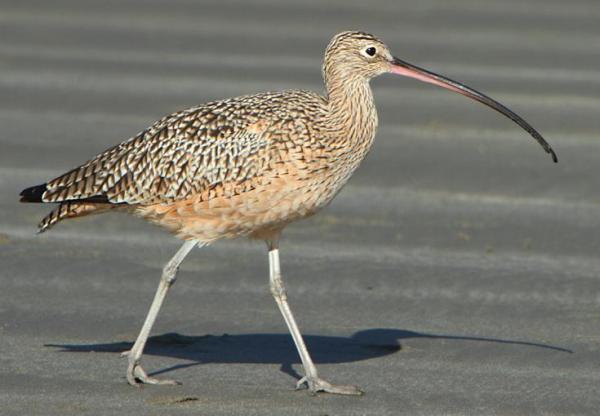
Long-billed birds (Ciconiiformes order)
Within this group, the following birds stand out:
- Storks: in addition to their beaks, these waterfowl also have long necks and long legs that allow them to wade through waterlogged areas in search for food. These birds can be found in many different continents, such as Europe, Asia, Africa and only three species in America.
- Herons: like storks, their fine and long beaks allow them to fish. Their long legs allow them to walk and be near water without wetting their feathers. These are found on all continents except Antarctica.

Long-billed birds of the Pelecaniformes order
As for this type of long-beaked bird, the following stand out:
- Pelicans: these birds are characterized by their long and strong hooked beak, which also has a gular pouch or sac under their lower jaw that allows them to catch their prey when fishing and sometimes retain fresh water. They are present on almost all continents, with the exception of Antarctica.
- Ibis: present in the southern hemisphere in warm and temperate zones, these species have long, downward curved necks and beaks with which they forage for food by probing areas flooded with water, sand or soil.
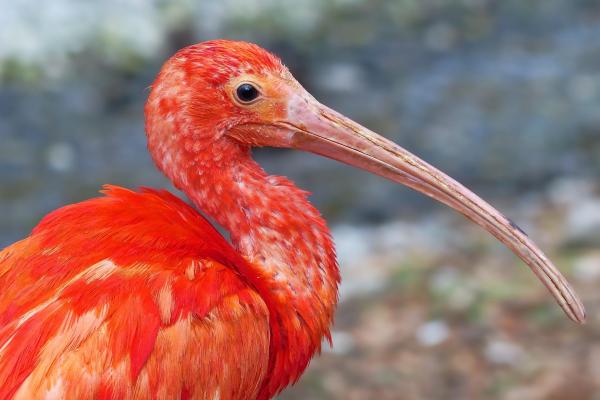
Long-billed birds of the Apodiformes order
Among this type of birds, the hummingbird especially stands out. In addition to being so striking for their small size and flight, these birds have characteristic fine and long beaks. They feed on the nectar of flowers and, due to this, some species have evolved together with plant species.
One example is the Great-billed Hummingbird (Ensifera ensifera) whose beak is so long that it is almost the only animal that It is responsible for pollinating the flowers of only a few plants. In addition, it is the species of bird with the longest beak in the world in relation to its total body length.
You may also be interested in learning about the Mayan Hummingbird.
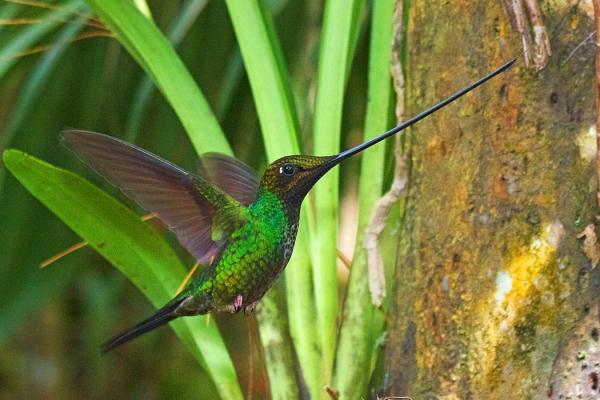
Long-billed birds of the Passeriformes order
Some of the long-billed birds in this order are:
- Picoguadañas, trepadores or picapalos (Campylorhamphus spp.): they are distributed throughout the Neotropics to the north of Argentina, and it is conspicuous and characteristic species whose beak is long and very curved that it uses to dig through the branches and holes of the trees.
- Long-tailed Nuthatch (Nasica longirostris): This bird is native to the Amazon in South America, very characteristic for its long and straight beak that it uses as a clip to look for insects between the bark of the trees and the leaf litter.
You may also be interested in our article about 10 exotic birds in the amazon forest.
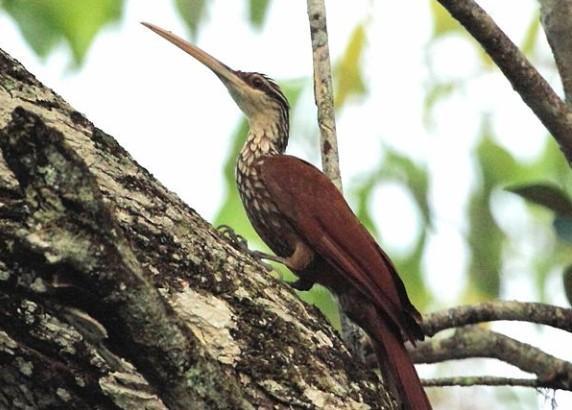
List of birds with long beaks
- Dalmatian Pelican (Pelecanus crispus)
- Rhinoceros Hornbill (Buceros rhinoceros)
- Stork (White Stork) (Ciconia ciconia)
- Kiwi (Aptery)
- Shoebill (Balaeniceps rex)
- Toco Toucan (Ramphastos toco)
- Bald Eagle (Haliaeetus leucocephalus)
- Lesser Flamingo (Phoeniconaias minor)
- Australian Pelican (Pelecanus conspicillatus)
- Woodpecker (Picidae)
- Sword-Billed Hummingbird (Ensifera ensifera)
- Keel-Billed Toucan (Ramphastos sulfuratus)
- American Avocet (Recurvirostra Americana)
- Great Hornbill (Buceros bicornis)
- Roseate Spoonbill (Platalea ajaja)
- Collared Aracari (Pteroglossus torquatus)
- American White Pelican (Pelecanus erythrorhynchos)
- Black Skimmer (Rynchops niger)
- Long-Billed Curlew (Numenius americanus)
- Southern Yellow-Billed Hornbill (Tockus leucomelas)
- and more...
Want to see more examples of birds with long beaks? Check out this video by Just6F!

If you want to read similar articles to Types of Birds With Long Beaks, we recommend you visit our Facts about the animal kingdom category.
- Barbosa, A. (1997). General characteristics of the biology of waders. Waders in Spain. Autonomous Body. National Parks. Madrid, 13-21.
- Colorado, G., & Gabriel, J. (2004). Relationship of bird morphometry with food guilds. SAO Bulletin, 14 (27), 25-32.








